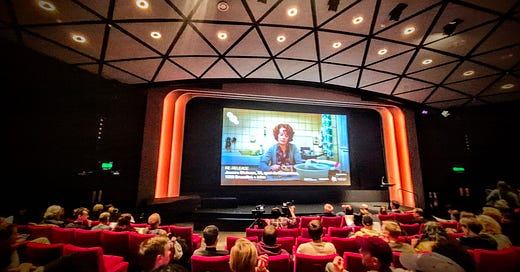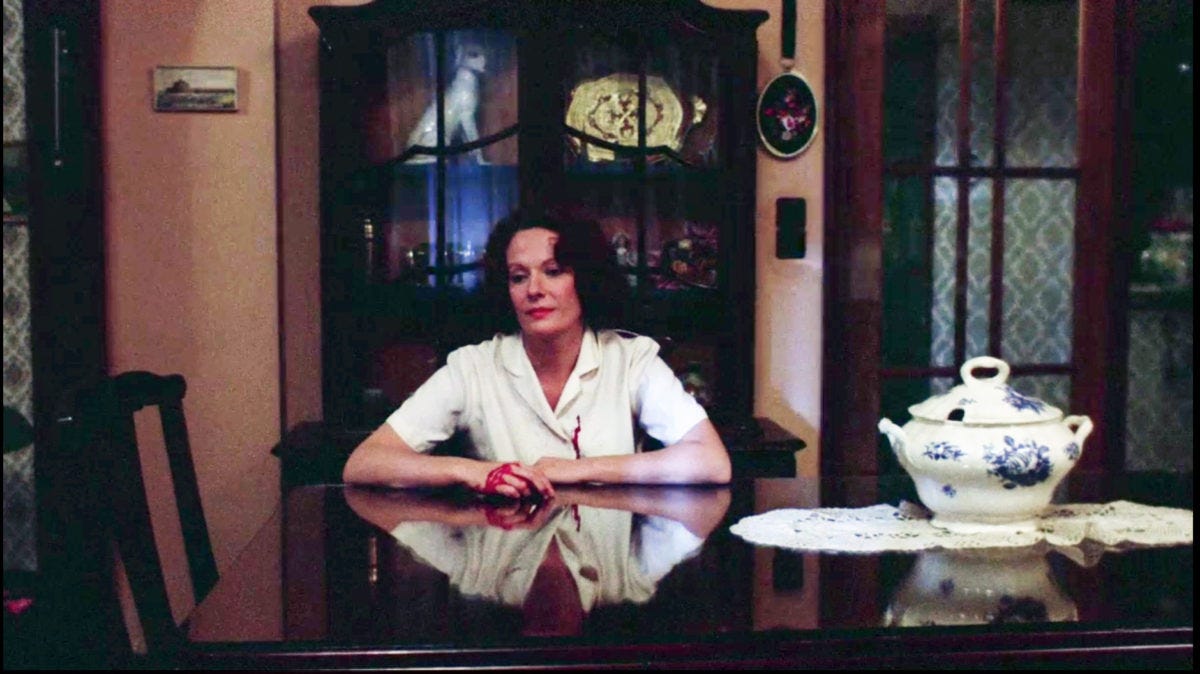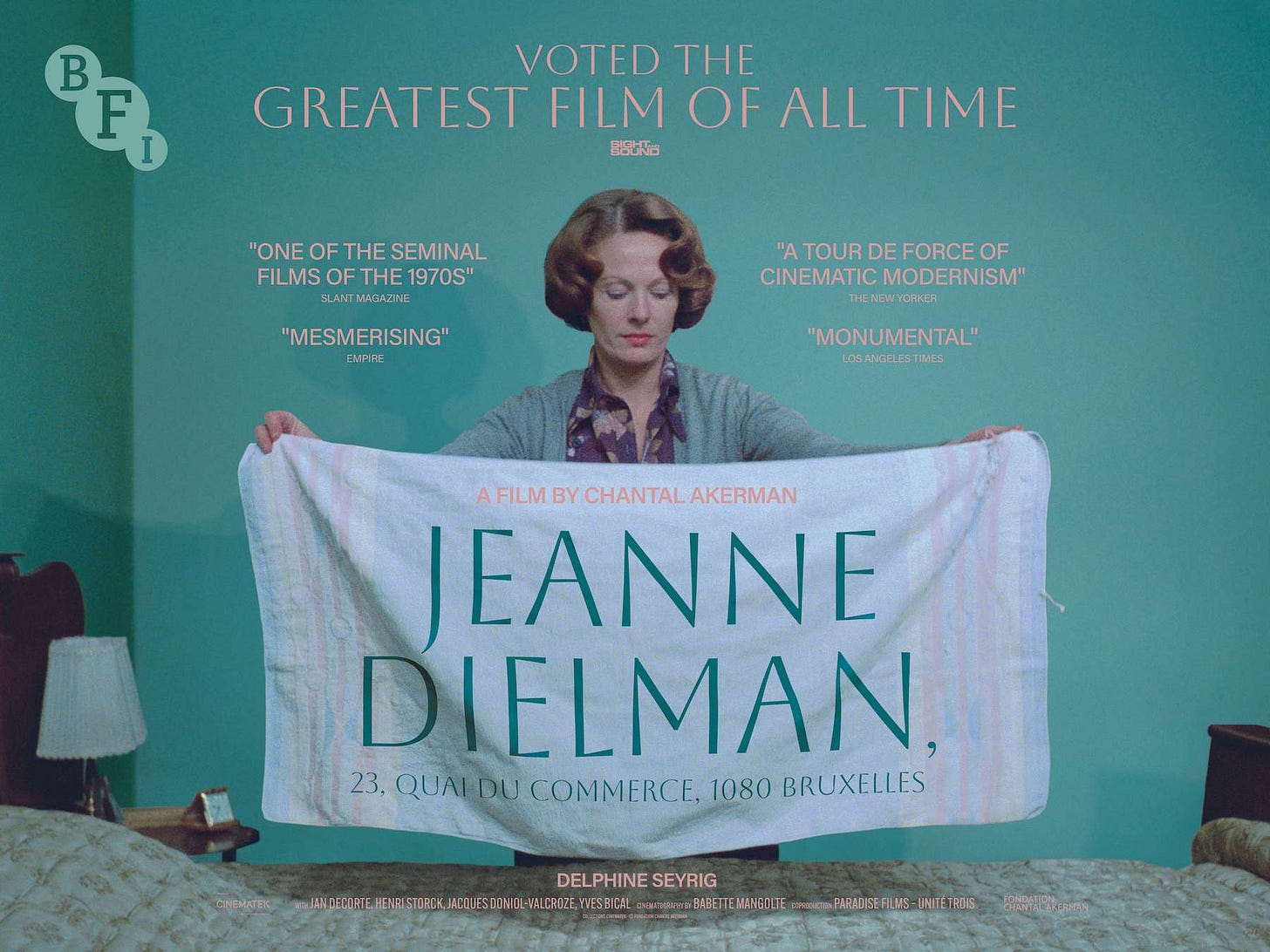In the Time of Jeanne
Filmmaker Chantel Akerman once said that she wants audiences of her work to "feel time". I embraced that notion in a recent screening of her masterpiece Jeanne Dielman.
Friday
Heading to NFT 1, the main screening room at the BFI Southbank, to rewatch Jeanne Dielman, 23 Quai du Commerce, 1080 Bruxelles felt almost like a pilgrimage. Ever since the autumn of 2022—when this three-and-a-half-hour avant-garde, largely narrative-less, feminist meditation on three days in the life of a Belgian housewife and part-time prostitute was crowned the greatest film of all time in Sight and Sound magazine’s once-a-decade poll—rewatching it in the auditorium space had become in my mind, something of a cinephilic obligation. But one willingly undertaken.
I say rewatch, but I can’t say with any definitive honesty that I had either seen the film projected or viewed it in a smaller format in its entirety. I have a vague memory of taking out a VHS tape from the library at Sheffield Hallam University, perhaps having read about its radicalism and seminal impact.
I doubt I was in a position, either intellectually or emotionally, to appreciate—let alone interpret—what I saw. As a film student, Akerman is a star name in a solar system one is conditioned to appreciate, with Jeanne Dielman being the biggest planet orbiting her auteurist center of gravity.
I returned to Jeanne Dielman in a module I taught on film aesthetics and European Modernism. Without a doubt, I did not screen the film in its entirety for students, probably falling into clichés about it being “long,” “slow,” and “difficult,” but at least, I think (I hope), suggesting that there was a method to its formal approach. Clipping sequences of Jeanne Dielman, I realise now, is risible in its contradiction to Akerman’s intention regarding time.
As I settled into my seat, I felt a sense of readying myself—not for the ordeal of some kind of physical or cognitive endurance test. This was more about wanting to actively embrace a certain mode of watching. I wanted to be present, embracing what are Akerman’s central cinematic conceits: that you should feel the passing of time.
To that end, I resolved not to look at my watch. I wanted the passing of time to be affectively felt and to be in sync with the protagonist’s experience of time. I tried, as much as possible, to disassociate from any notion of the “objective” time my watch would anchor me to, or the running time of the film.
The demographic of the sold-out screening was younger than I expected. This definitely wasn’t the creaking corpus of aging aficionados (like myself?).
Laura Mulvey stepped up on stage to introduce the film. Now in her 80s, her diminutive stature belies her almost mythic status in film studies circles. It amused me that her head only just appeared above the lectern, with two microphones protruding above her like antennae.
I’ve heard her speak many times before and was immediately attuned to that persuasive, expressive cadence of her voice. Think of John Berger’s rolling R’s filtered through Angela Rippon’s newsreader precision. It’s a vocal tone that feels both anachronistic and somehow refreshingly earnest. Very much antithetical to the insistent “pay me attention” delivery that is today’s default.
Mulvey is one of the few people who can authentically compare the context of the film’s release—how its radicalism was in tune with the politics of the mid-seventies—to the renaissance of international recognition and disruption in the aftermath of the Sight and Sound poll. She repeats the mantra: “There was cinema before Jeanne Dielman, and cinema after Jeanne Dielman.”
Bringing her remarks to a close, Mulvey returns to the theme of time. Maybe I’m not alone in thinking we are all here to watch time, as she jokes: “I’ll stop now because I know you’re already waiting for the film to start.”
I get my notebook out. Normally, I don’t take notes while watching a film. But I feel the urge to record some impressions. Maybe this is a cop-out? Another way of avoiding just sitting with time.
The tone of the film from the start is so matter-of-fact: she is boiling potatoes. The framing, which Akerman is synonymous with, is immediately apparent. A waist-high camera, the kitchen shot at one of two 90-degree angles.
Her first male visitor arrives at the flat in the first few minutes of the film.
The soundtrack is loud, almost peaking. Jeanne shuts doors and turns lights on and off every time she enters and leaves a room. Her heeled footsteps on the floors are rhythmical and harsh. Time, space, and movement all register through that sound.
I feel a wave of nostalgia pass over me when the son puts his satchel on the table and removes his school books and pencil case.
The blue neon light flashes into the rooms, cutting through at angles. It flashes insistently throughout the film.
With such long takes and time spent in the same locations, with the same still framing, I start to explore the image. The glasses Jeanne and Sylvain drink from are like those you would buy from a cheap tourist shop. In the bedroom, a dark wardrobe looks like a coffin.
I was four years old when this came out. I’m 51 now. I wonder how much of my life has been taken up by performative, repetitive tasks. Does everyone, regardless of gender or circumstance, use an abdication of choice as a coping mechanism? Is life merely a default to accidental patterns of behavior?
Jeanne spends more time outside the flat than I remember, visiting various shops and a café.
As we follow Jeanne in the corridor of her building, I see the similarity with Kubrick’s The Shining. The comparison lies in the one-point composition of spaces. When used in the kitchen, the living room, or the bedroom, this gives the “frontal gaze” associated with Akerman. But when the same shot is used in corridors or open spaces, the depth of field creates an eerie disassociation.
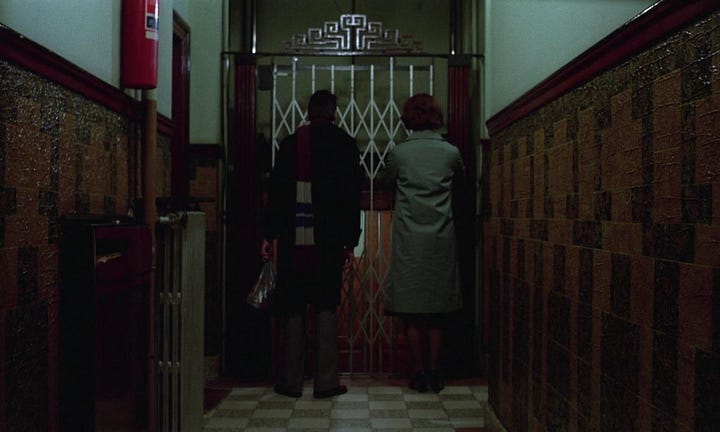



Jeanne sits down for only a moment and sighs. Is she trying to relax? She gets up and goes back to the kitchen to prepare food. I’m not sure now that there is any choice being made in her actions. If she sits and thinks for a moment then she could slide into the depths of despair.
Turning off the lights every time she leaves a room is really starting to grate on me. I don’t know why. Perhaps it’s the sense of pointlessness, if she is returning to that same room a moment later.
The doorbell rings. Jeanne takes a baby from a mother who does not come in. It’s Akerman herself who plays the unseen neighbor. Jeanne just leaves the crib on the table and carries on with her tasks. When she comes back fleetingly to give the baby a quick look, the audience laughs at her seeming disinterest.
Jeanne has to peel more potatoes, having burnt the first batch. She does this with a vicious resentment. This is the first moment I feel that these tasks, and the silent meticulousness with which she performs them, have shifted from being a coping mechanism to a prison. The moment epitomises the interior strength of Seyrig’s performance. Somehow, even though her face that still look blank and vacant, the way her hand scape away the skin, embodies the frustrations and regrets of her life .
She drops the brush she uses to shine the boys shoes. This ruptures to the routine are like minute psychological ruptures.
At the end of the second day, in evening Jeanne and Sylvain go out somewhere. He doesn’t want to go. But see ignores the request. We don’t find out where.
This is moment Sylvain explains with a kind of deadpan knowingness, is oedipal anxiety. It’s a ridiculous moment and the audiences laughs at his weird earnestness.
Someone drops a glass behind me. Several people turn. Eerily, Jeanne gets up from the kitchen table immediately after the noise, as if she heard it and moved to clean it up.
Jeanne hair is like a sculpture, a sheer clay mould rather than individual fibres. She spends time on it. After she come out of the room having has sex with her afternoon clients, her hair is ever so slightly messy.
Three people sitting in different parts of the auditorium all leave at the same time: after the second day. Why then? We must be over two and a half hours in. Surely if you weren’t able to get into the film you could figure that out after about half an hour.
Day three has started. I have the sense that things are building to a denouement. Is this because I know that the film ends on Jeanne’s third day, or that the time has invested these ostensibly banal actions with portentousness?
Jeanne goes out to try and find a button for. She can’t fine the right button for a jacket she has for the boy.
There audible sound from some in the audience - is it an intake of collective breath or an exhale”?. I smile when she comes back to the cafe for the second (third?) time and her table is taken.
She takes the baby once again. It cries incessantly. Jeanne picks up the baby several times making it cry even more. The audience are laughing as Jeanne shakes the baby quite forcibly, then sets it down. Is this supposed to be intentionally funny.
The last client has arrived. We are finally allowed to see inside the room. The man lies on top of her, still, almost catatonic. He is moving. He finishes with guttural groan. She extricates herself from under him.
Jeanne goes back to the mirror. The man, who has an ostentatious moustache, watches her intently. We are looking at this through the mirror. There are a pair of scissors on the dresser. Are my eyes drawn to the them because I know what’s coming? If I didn’t do they still draw the eye?
The man lays back on the bed, as though claiming some kind of, I don’t know, victory, ownership, satisfaction.
Jeanne picks of the scissors and thrusts them into his neck. An audible gasp from many in the audience.
Jeanne sits at the kitchen table. The pot where she keens the money made from these men to her side. There’s a blood stain on her cream blouse and blood on her knuckles. The neon light flashes through the space. She sits like this for several minutes, or was it hours?
Saturday
I’m in the BFI library reading more about Akerman and Jeanne Dielman.
Of course, there are myriad contextualisations of Akerman’s body of work and interpretations of specific films. To me, though, it’s more fascinating to read reflections on the processes of watching. Jonathan Rosenbaum, in his review originally published in the Winter 1975-76 edition, writes:
“At one point, I leave the cinema for a few minutes—partially for a cigarette and partially to see what it feels like not watching the movie—and when I return, I don’t feel like I’ve missed anything important. Yet something keeps me watching, although I’m not sure precisely what.”
(Rosenbaum in Chantal Akerman (Sight and Sound: the auteur series: 28))
There are two aspects to this that intrigue me. First, that Rosenbaum sees fit to interrogate his position as a viewer and wants to know what it feels like not to be in the circumstance of the film, then reintroducing himself to that circumstance. Second, that he is still compelled to continue viewing without a clear sense of intention.
This infers the notion that Akerman’s film requires a viewing approach of curiosity without expectation.
Another piece I read on Akerman captures how time and space transcend the two-dimensional screen to a three-dimensional sense of embodied experience, written by Giuliana Bruno. She states:
“Her itinerant way of filming was especially suited to the peripatetic mode of reception experienced in the art gallery, where visitors interact with screens that can enhance displacement as well as forms of encounter and liminality… Akerman’s screen is a porous material that mediates an intensive sense of projection, a relationship between inside and outside, physical and mental space.”
(Bruno, Giuliana. “In Memory of Chantal Akerman: Passages Through Time and Space.” In Schmid, M. & Wilson, E. Chantal Akerman: Afterlives. Legenda. p. 9)
It’s valid that Jeanne Dielman would be equally viable (perhaps even more appropriate) to a gallery space. That sense of the film as an encounter with an ongoing other dimension, without beginning or end, aligns with its temporal-spatial structure. But then I wonder whether this would be altogether contrary to Akerman’s ethos of wanting the viewer to “experience time.”
In Sheila O’Malley’s piece for Film Comment—“Present Tense: Audience vs. Alone”—she states:
“…when I think about the first time, I remember one thing and one thing only: when Delphine Seyrig, busy in her cooking routine, dropped a fork. A woman a couple of rows away from me, who was also probably seeing it for the first time, gasped in terror. I had been completely wrapped up in the film, but when the woman gasped at the most mundane sight imaginable, I suddenly understood Jeanne Dielman’s towering reputation on a visceral level. Dazzled, I thought to myself, ‘My God, everyone was right, this is a stone-cold masterpiece.’ It’s possible I would have come to the same conclusion if I had seen the film alone in my apartment, but it would have been a very different experience.”
This is indeed the genius of the film: how it works on its own terms but also as an experimental, radical reminder of the collective investment in the cinematic experience. As a corpus of viewers, there is an energy that builds through the resonance of time and focus on those flickering lights and the worlds they create. This is true of all films, of course. But perhaps the criterion for greatness is the depth of resonance a film is capable of reaching. Those adjectives: “difficult,” “slow,” and “long,” if you reverse them to “easy,” “fast,” and “short,” are emblematic of a culture that has forgotten how to be immersed in the resonance of time. Jeanne Dielman, yes, can be understood as a masterpiece of feminist cinema or modernist aesthetics. For me, it is definitive as a film that doesn’t just require watching; it requires you to watch yourself watching.
Sunday
Back in 2022, I recorded a double episode of The Cinematologists Podcast in collaboration with the BFI for the release of their once a decade poll. I think it’s fair to say that any system of ranking art has to come with a substantial dose of skepticism.
Katsali’s recent piece on her experience with Jeanne Dielman is a thoroughly readable forensic unpacking of the ways in which hierarchies of taste in art are indicative of culture discourse and the agendas of socio-historical context and certain vested interests therein.I was one of the newbies invited to vote in 2022. Jeanne Dielman was not on my list at that time. For what it’s worth, it would be now. I realise that this comes across as the most egregious case of after timing/band wagon jumping. Indeed, thinking about uncertain balance between subjectivity/objectivity that is implied in anyone’s list, I would have to reframe my criteria of judgment in it’s entirety. As much as anything else, it’s the audaciousness of Jeanne Dielman that perhaps the most impressive thing. That at 25, Akerman was able to manifest a piece of art that seems to be so complete of itself and so definitely a part expression of a pure ontology of the cinema medium.
These questions of canonicity, and how the discourse of cinematic greatness were reframed by Sight and Sound’s poll was the focus of a recent Cinematologists Podcast focusing on the BFI retrospective. I spoke to Céline Brouwez, the co-ordinator of the Fondation Chantal Akerman at CINEMATEK, and season curator Isabel Stevens from Sight and Sound Magazine.
The discourse surrounding the Sight and Sound poll result and its aftermath as a cultural moment frames the chat. Céline gives unique insight into the incredible impact of the poll result on her organisation, both in a economic sense but also as a boon to cultural heritage of Belgium itself. Isabel relives the night of the big announcement and the immediate shockwaves that ran through not only cinephile circles but the international media.
One of the things that this retrospective is keen to address is Akerman's body of work beyond Jeanne Dielman and her eclectic ouvre. We think through the breadth of her work, which has few generic boundaries. Discuss the work of archiving, restoration and presentation. And, of course, we explore Akerman's identity: her formative experience, the influence of her mother, and her rigorous form borne of a commitment to artistic commitment and morality.
Listen to that episode here, or wherever you pod:
If you want to dive even further into Chantal Akerman, for paid members I have upload a video bonus episode of the podcast in which Neil and I discuss Akerman’s follow up to JD: Les Rendez-vous d’Anna.
profound study of acute loneliness, starring a wonderfully ethereal Aurore Clément as a filmmaker traveling from Cologne to Paris. Clearly, there are autobiographical elements to the scenario and the characterisations. Indeed, we discuss the central sequence in which the character of Anna meets with her mother and reveals that her only sense of intimacy, or even love, emerged in a relationship with another woman.
This is one of the few moments that Anna specifically tries to interrogate her loneliness, but it's not reciprocated.
We talk about the aesthetic and narrative structure of the film as a whole—a study of alienation, which has much in common with the films of Antonioni, but of course with Akerman's singular point of view and its feminist invocations.
The rigorous style is there. The train stations, hotels, and other interstitial spaces are shot with the geometric, front-on gaze that allows the viewer to see through Akerman's cinematic eye, but with the freedom to explore the frame. A brilliant film, which is somewhat more accessible than Jeanne Dielman, but as a follow-up shows a filmmaker both pushing her style further while perhaps questioning her own ambivalent feelings as a female filmmaker.
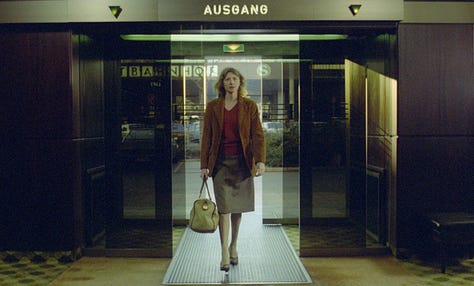
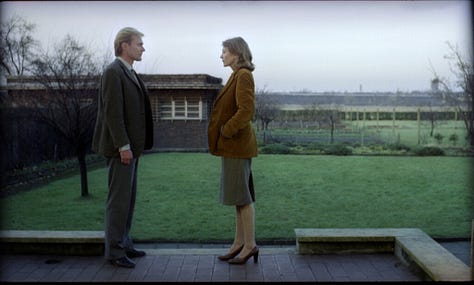
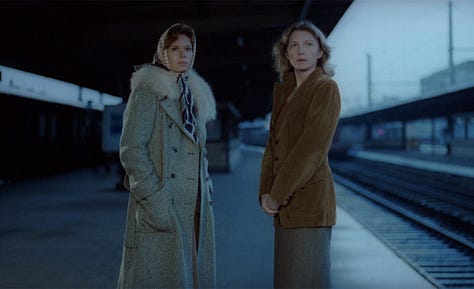
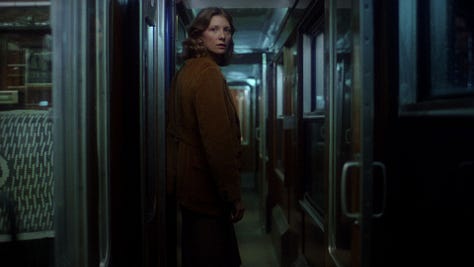
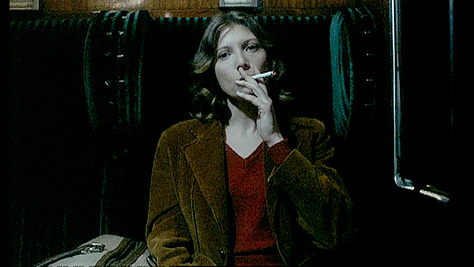

As always, thanks for reading, watching, or listening. If you are not already a subscriber, please consider doing so by hitting the button below. Also, if there’s anything here that strikes you as interesting, useful, or even mildly amusing, please feel free to share it in the Substack app or on any of those other platforms we like to decry but also can’t live without.
Sharing and commenting (not just liking) is a gesture of curatorial practice and a morsel of resistance against complicity with the algorithmic overlords.
Lastly, if you have the means to afford a paid subscription for only £3.50 per month, you receive access to the paid portion of my work, which includes podcasts, extended interviews, and bonus writing. Every paid subscriber also receives an IRL postcard from me through the post.
Alternatively you can contribute individual amounts through “buy me a coffee” below.
I know it’s hard when there are so many ways one’s attention and money are solicited, so I truly appreciate any support in helping me to build this Substack.
Keep reading with a 7-day free trial
Subscribe to Contrawise to keep reading this post and get 7 days of free access to the full post archives.


